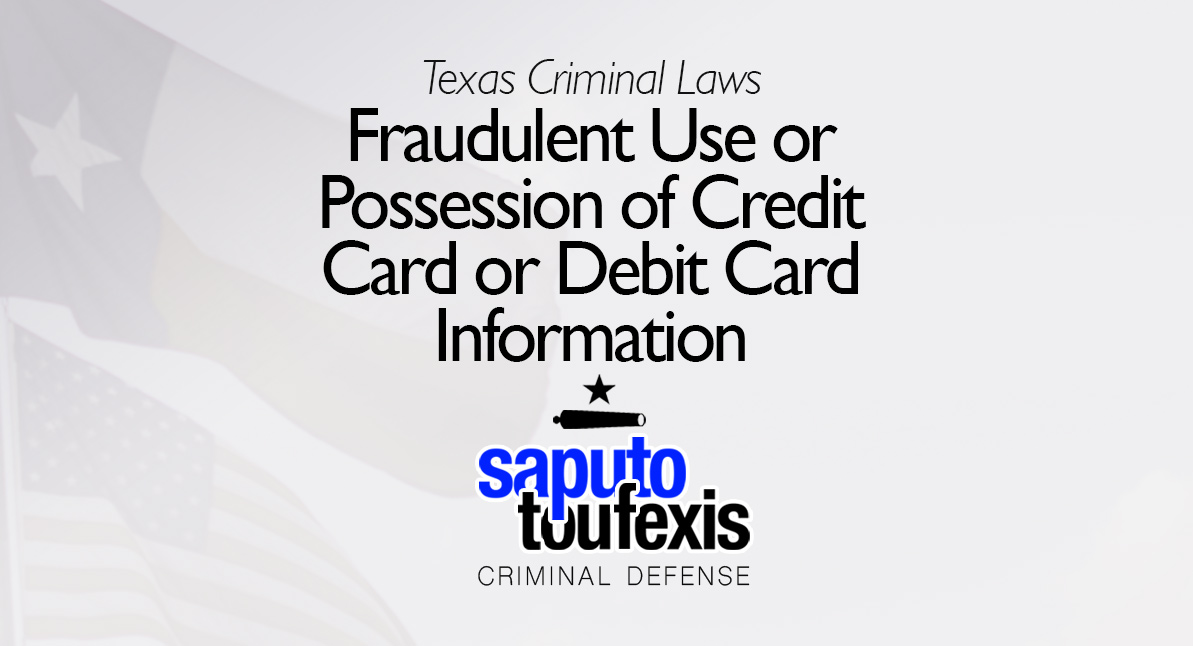The Texas Fraudulent Use or Possession of Credit Card or Debit Card Information law gives police the right to arrest you if they believe you obtained, possessed, transferred, or used a counterfeit credit card or debit card, the number and expiration date of a card without the consent of the account holder, or the data stored on the digital imprint of a card without the consent of the account holder, and you did so with the intent to defraud or otherwise harm someone.
FAQs about the
Fraudulent Use or Possession of Card Information law in Texas
- What is the current Texas law about Fraudulent Use or Possession of Credit Card or Debit Card Information?
- How can I be charged with a Fraudulent Use or Possession of Card Information offense in Texas?
- What is the statute of limitation for Fraudulent Use or Possession of Card Information in Texas?
- What is the penalty for a Texas Fraudulent Use or Possession of Card Information offense?
- Can you get probation for Fraudulent Use or Possession of Card Information in Texas?
- What level of crime is Fraudulent Use or Possession of Card Information in Texas?
The Texas legislature enacted this criminal offense in 2019 and codified it in Texas Penal Code Section 32.315. The legislature did not update this law in 2023. In fact, this law has not been amended since its enactment.
The Penal Code classifies the Texas Fraudulent Use or Possession of Card Information law under Title 7 “Offenses Against Property,” Chapter 32 “Fraud.” Learn more about the Texas offense of Fraudulent Use or Possession of Credit Card or Debit Card Information below.
What is the current Texas law about Fraudulent Use or Possession of Credit Card or Debit Card Information?
Texas law currently defines the offense of Fraudulent Use or Possession of Credit Card or Debit Card Information in Penal Code Section §32.315 as follows:[1]
(b) A person commits an offense if the person, with the intent to harm or defraud another, obtains, possesses, transfers, or uses:
(1) a counterfeit credit card or debit card;
(2) the number and expiration date of a credit card or debit card without the consent of the account holder; or
(3) the data stored on the digital imprint of a credit card or debit card without the consent of the account holder.
The offense was created by the 86th Texas Lesgislature and became effective on September 1, 2019.[2]
How can I be charged with a Fraudulent Use or Possession of Card Information offense in Texas?
You can be charged with Fraudulent Use or Possession of Credit Card or Debit Card Information in Texas if the state’s attorneys believe that you each of the elements of (b)(1), (2) or (3), as described in the section above, have been met.
What is the statute of limitation for Fraudulent Use or Possession of Card Information in Texas?
Fraudulent Use or Possession of Card Information offenses have a three-year limitations period.[3]
What is the penalty for a Texas Fraudulent Use or Possession of Card Information offense?
The lowest penalty classification for Fraudulent Use or Possession of Credit Card or Debit Card Information is a state jail felony and applies if the number of items obtained, possessed, transferred, or used is less than five.[4]
The classification level increases to a third degree felony if the number of items obtained, possessed, transferred, or used is five or more but less than ten.[5]
The classification level further increases to a second degree felony if the number of items obtained, possessed, transferred, or used is ten or more but less than fifty.[6]
The classification level increases to a first degree felony if the number of items obtained, possessed, transferred, or used is fifty or more.[7]
Can you get probation for Fraudulent Use or Possession of Card Information in Texas?
The Texas Code of Criminal Procedure allows both judges and juries to grant probation for Fraudulent Use or Possession of Card Information, and judges are also allowed to accept deferred adjudication plea deals.[8]
Note, however, that no matter the offense, neither judges nor juries may recommend community supervision for any suspended sentence of over 10 years.[9] Also, judges may not grant community supervision after a conviction if (1) the defendant used or exhibited a deadly weapon during the commission of the felony or immediate flight thereafter and (2) the defendant used or exhibited the deadly weapon himself or was a party to the offense and knew that a deadly weapon would be used or exhibited.[10]
What level of crime is Fraudulent Use or Possession of Card Information in Texas?
The Penal Code classification of the punishment for Fraudulent Use or Possession of Card Information ranges from a state jail felony to a first degree felony, depending on the number if items involved.
Learn more about the penalty range for this offense in the section above.
Legal References:
^1. Texas Penal Code §32.315. This law is current as of 2024.^2. HB 2625, 86th Texas Legislature, Section 1^3. See Code of Criminal Procedure 12.01(9)^4. Texas Penal Code §32.315(e)(1), as enacted by HB 2625 in the 2019 Texas Legislative Session^5. Texas Penal Code §32.315(e)(2), as enacted by HB 2625 in the 2019 Texas Legislative Session^6. Texas Penal Code §32.315(e)(3), as enacted by HB 2625 in the 2019 Texas Legislative Session^7. Texas Penal Code §32.315(e)(4), as passed by HB 2625 in the 2019 Texas Legislative Session^8. See Chapter 42, Texas Code of Criminal Procedure, Art. 42A.054, Art. 42A.056, Art. 42A.102^9. Art. 42A.053(c), Texas Code of Criminal Procedure^10. Art. 42A.054(b), Texas Code of Criminal Procedure










